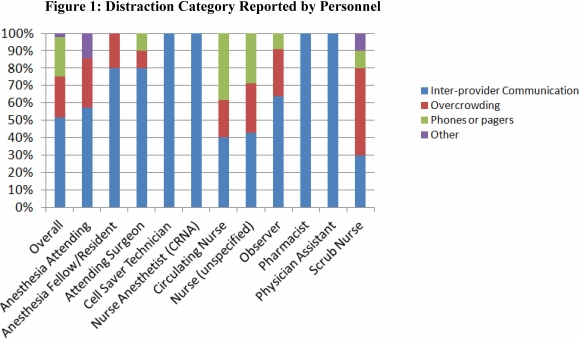A Multi-Center Study of Factors That Increase Cognitive Load in Living Donor Liver Transplants.
A. Lee,1 R. Khorzad,1 E. Pomfret,2 J. Guarrera,3 R. Fisher,4 M. Simpson,2 A. Skaro,1 A. Daud,1 N. Salehitezangi,1 D. Woods,1 D. Ladner.1
1Northwestern University, Chicago, IL
2Lahey Clinic, Burlington, MA
3Columbia University, New York, NY
4Virginia Commonwealth Univeristy, Richmond, VA.
Meeting: 2016 American Transplant Congress
Abstract number: A218
Keywords: Liver transplantation, Living-related liver donors, Outcome, Safety
Session Information
Session Name: Poster Session A: Living Donor Liver Transplantation
Session Type: Poster Session
Date: Saturday, June 11, 2016
Session Time: 5:30pm-7:30pm
 Presentation Time: 5:30pm-7:30pm
Presentation Time: 5:30pm-7:30pm
Location: Halls C&D
Background: Studies have shown that distractions in the operating room (such as phones/pagers, irrelevant conversations, ins and outs) can negatively affect concentration and performance, and increase the rates of medical error as they can lead to cognitive overload.
The study objective was to characterize and qualify distractions that occur and according to the healthcare professionals increase the cognitive load during one of the most complex surgeries, living donor liver transplantation (LDLT).
Methods: Web-based Safety (WBS) debriefings were conducted of all clinicians (e.g. nurses, physicians, technicians, etc) participating in LDLTs at four large LDLT center, as part of an ancillary Adult-to-Adult Living Donor Liver Transplant cohort study (A2ALL) between 10/2010 -1/2014. WBS was designed to elicit feedback about any issues occurring during surgery, including distractions. The WBS reports related to distractions were extracted, and then categorized into subgroups: 1) miscommunication, 2) phones or pagers, 3) overcrowding, or 4) other and analyzed.
Results: 134 LDLT surgeries were debriefed and 315 incidents were reported. 101 (32%) reports were related to distractions. Ineffective communication was the most common problem reported (51%) by every personnel role at every institution and was often reported by multiple personnel working on the same case. The percentage of phones and pages was 23%, overcrowding was 24% and other was 2%. The incidence of reports of phones and pagers and overcrowding showed significant variation (0-33% and 0-38% respectively) between different transplant centers. 
Conclusion: These results demonstrate that distractions are surprisingly common even in complex surgeries requiring particular attention and coordination from all healthcare providers. To optimize patient outcome and safety especially in LDLT, practices to minimize distractions during surgery need to be implemented.
CITATION INFORMATION: Lee A, Khorzad R, Pomfret E, Guarrera J, Fisher R, Simpson M, Skaro A, Daud A, Salehitezangi N, Woods D, Ladner D. A Multi-Center Study of Factors That Increase Cognitive Load in Living Donor Liver Transplants. Am J Transplant. 2016;16 (suppl 3).
To cite this abstract in AMA style:
Lee A, Khorzad R, Pomfret E, Guarrera J, Fisher R, Simpson M, Skaro A, Daud A, Salehitezangi N, Woods D, Ladner D. A Multi-Center Study of Factors That Increase Cognitive Load in Living Donor Liver Transplants. [abstract]. Am J Transplant. 2016; 16 (suppl 3). https://atcmeetingabstracts.com/abstract/a-multi-center-study-of-factors-that-increase-cognitive-load-in-living-donor-liver-transplants/. Accessed December 11, 2025.« Back to 2016 American Transplant Congress
